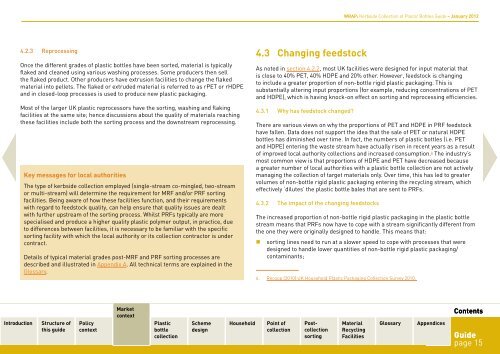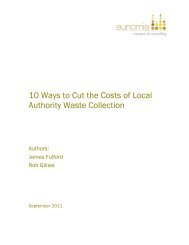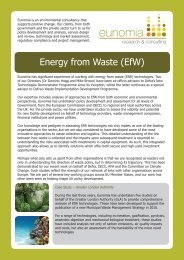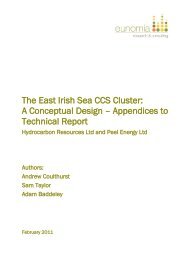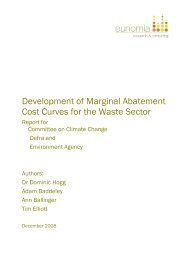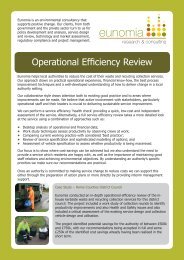Kerbside collection of plastic bottles Guide - Eunomia Research ...
Kerbside collection of plastic bottles Guide - Eunomia Research ...
Kerbside collection of plastic bottles Guide - Eunomia Research ...
- No tags were found...
You also want an ePaper? Increase the reach of your titles
YUMPU automatically turns print PDFs into web optimized ePapers that Google loves.
WRAP: <strong>Kerbside</strong> Collection <strong>of</strong> Plastic Bottles <strong>Guide</strong> – January 20124.2.3 ReprocessingOnce the different grades <strong>of</strong> <strong>plastic</strong> <strong>bottles</strong> have been sorted, material is typicallyflaked and cleaned using various washing processes. Some producers then sellthe flaked product. Other producers have extrusion facilities to change the flakedmaterial into pellets. The flaked or extruded material is referred to as rPET or rHDPEand in closed-loop processes is used to produce new <strong>plastic</strong> packaging.Most <strong>of</strong> the larger UK <strong>plastic</strong> reprocessors have the sorting, washing and flakingfacilities at the same site; hence discussions about the quality <strong>of</strong> materials reachingthese facilities include both the sorting process and the downstream reprocessing.Key messages for local authoritiesThe type <strong>of</strong> kerbside <strong>collection</strong> employed (single-stream co-mingled, two-streamor multi-stream) will determine the requirement for MRF and/or PRF sortingfacilities. Being aware <strong>of</strong> how these facilities function, and their requirementswith regard to feedstock quality, can help ensure that quality issues are dealtwith further upstream <strong>of</strong> the sorting process. Whilst PRFs typically are morespecialised and produce a higher quality <strong>plastic</strong> polymer output, in practice, dueto differences between facilities, it is necessary to be familiar with the specificsorting facility with which the local authority or its <strong>collection</strong> contractor is undercontract.Details <strong>of</strong> typical material grades post-MRF and PRF sorting processes aredescribed and illustrated in Appendix A. All technical terms are explained in theGlossary.4.3 Changing feedstockAs noted in section 4.2.2, most UK facilities were designed for input material thatis close to 40% PET, 40% HDPE and 20% other. However, feedstock is changingto include a greater proportion <strong>of</strong> non-bottle rigid <strong>plastic</strong> packaging. This issubstantially altering input proportions (for example, reducing concentrations <strong>of</strong> PETand HDPE), which is having knock-on effect on sorting and reprocessing efficiencies.4.3.1 Why has feedstock changed?There are various views on why the proportions <strong>of</strong> PET and HDPE in PRF feedstockhave fallen. Data does not support the idea that the sale <strong>of</strong> PET or natural HDPE<strong>bottles</strong> has diminished over time. In fact, the numbers <strong>of</strong> <strong>plastic</strong> <strong>bottles</strong> (i.e. PETand HDPE) entering the waste stream have actually risen in recent years as a result<strong>of</strong> improved local authority <strong>collection</strong>s and increased consumption. 6 The industry’smost common view is that proportions <strong>of</strong> HDPE and PET have decreased becausea greater number <strong>of</strong> local authorities with a <strong>plastic</strong> bottle <strong>collection</strong> are not activelymanaging the <strong>collection</strong> <strong>of</strong> target materials only. Over time, this has led to greatervolumes <strong>of</strong> non-bottle rigid <strong>plastic</strong> packaging entering the recycling stream, whicheffectively ‘dilutes’ the <strong>plastic</strong> bottle bales that are sent to PRFs.4.3.2 The impact <strong>of</strong> the changing feedstocksThe increased proportion <strong>of</strong> non-bottle rigid <strong>plastic</strong> packaging in the <strong>plastic</strong> <strong>bottles</strong>tream means that PRFs now have to cope with a stream significantly different fromthe one they were originally designed to handle. This means that:• sorting lines need to run at a slower speed to cope with processes that weredesigned to handle lower quantities <strong>of</strong> non-bottle rigid <strong>plastic</strong> packaging/contaminants;6. Recoup (2010) UK Household Plastic Packaging Collection Survey 2010,IntroductionStructure <strong>of</strong>this guidePolicycontextMarketcontextMarketcontextPlasticbottle<strong>collection</strong>SchemedesignHouseholdPoint <strong>of</strong><strong>collection</strong>Post<strong>collection</strong>sortingMaterialRecyclingFacilitiesGlossaryAppendicesContents<strong>Guide</strong>page 15


